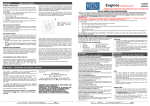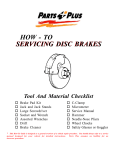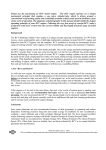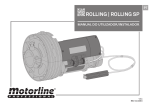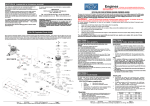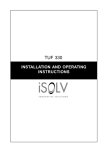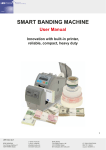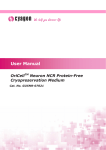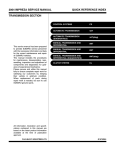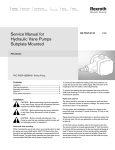Download Engines Ltd
Transcript
SECTION 7 d CARE OF YOUR RCV NORMAL MAINTENANCE Regularly check all screws and nuts on the engine, propeller and muffler At the end of each days flying it is recommended that a few squirts of clean machine oil “after run oil” are introduced into the crankcase via the crank breather. If the engine is to be removed from the model and laid up for any significant period, we recommend the following:• Ensure there is no fuel left in the engine • Remove the glow plugs • Flush out the engine with good quality after-run oil • Store the engine on the plane with the nose down to keep oil in the bearings Some owners may prefer to strip the engine and clean using methanol or straight fuel, for instructions see next section. The engine is timed at top dead centre between the inlet and exhaust stroke. At this point in the cycle the cylinder port is exactly halfway between the exhaust and inlet. If the engine is assembled so that the piston is at top dead centre when the cylinder port is halfway between the exhaust and inlet, then it is timed correctly. Insert a 5mm Allen key in the starter drive Allen screw. Turn the crank to top dead centre. Carefully note the angle the Allen key assumes when at top dead centre, and as an additional check mark the top of the starter drive Allen screw to mark the position of top dead centre. When timing ring is set correctly, daylight can be seen through inlet/exhaust ports as shown. The RCV is supplied with a spare starter cap screw which may become worn. When this occurs it should be removed using a 5 mm Allen key and replaced with the spare supplied. The engine can be prevented from rotating when the screw is removed or tightened by holding the propeller. SPLITTING THE RCV DISMANTLING PROCEDURE Remove the carburettor and exhaust. Remove the four Allen headed M3 screws holding the cylinder jacket to the crankcase. Carefully ease the cylinder jacket off the crankcase, ensuring the small plastic pad* is not mislaid. (*RCV60SP & RCV90SP = R60208 ; RCV120SP = R120208) NO FURTHER DISMANTLING IS NOW NECESSARY. REASSEMBLING AND TIMING THE RCV Reassembly of the engine is a simple operation. The main difficulty is in ensuring that the gears are engaged in the correct position so that the engine is timed correctly. ABOVE ALL THE TIMING MUST BE CHECKED CAREFULLY BEFORE BOLTING THE CARB AND EXHAUST BACK ONTO THE ENGINE. *To validate this guarantee we must receive your completed warranty form and proof of purchase (send a copy of your receipt, & keep the original) within 1 month of purchase. This guarantee does not affect your statutory rights. Any engines being returned to RCV or our authorised service centres must have a returns number (issued by RCV) READ ALL INSTRUCTIONS BEFORE OPERATING YOUR RCV ENGINE! RC model airplanes and engines are not toys and are capable of causing serious injury to yourself and others if improperly used. You should always:- Keep hands and all foreign objects clear of the engine when it is operating ; Mount the engine securely on a bench mount or plane ; Use a good quality balanced propeller with no cracks or flaws, ensure this is tightened prior to each use ; Run your engine in an well ventilated area ; Do not hand start the engine, only use the behind the prop starting mechanism ; While the engine is running stand behind the engine to make adjustments and ensure proper safety clothing is always used (eg. eye goggles). The safe operation of your engine is your responsibility so ensure that you operate your engine with care at all times and ensure all spectators are kept at a safe distance. SECTION 1 RECEIVING YOUR ENGINE Take the cylinder jacket and rotate the cylinder until the cylinder port is equally visible in the exhaust and inlet ports. About 1/8 of the port should be visible in each. This will require a bright light shining directly down the inlet or exhaust port to be sure of the position of the port. Now insert two cocktail sticks (or similar suitable wooden or plastic implements) into the exposed segments of the port to lock the cylinder in position. Finally, holding both components in these positions, bring them together carefully with the four boltholes lined up. There are four possible rotational positions where the boltholes will line up. The one that is most convenient for the particular installation can be selected. As the cases are finally brought together the gears should mesh with no movement of either component. Now insert and tighten the four bolts and remove the cocktail sticks to free the cylinder. Do not attempt to rotate the engine until the bolts are done up at least finger tight as the compression will force the two halves apart and the gears will jump out of mesh. Rotate the engine one turn, until it is again at top dead centre between inlet and exhaust. Carefully check that the cylinder port is equally visible in the exhaust and inlet ports. If it is not, dismantle and carry out this assembly procedure again. SECTION 9 GUARANTEE & TECHNICAL SUPPORT Your engine is guaranteed free from manufacturing defects and workmanship for a period of 24 months from date of supply*. This warranty is limited to the original purchaser of the engine and is not transferable. This does not apply to damage caused by incorrect usage, handling, running in, non-observance of these instructions, or modification. Furthermore the manufacturers cannot be liable for any fault caused through incorrect assembly or disassembly-assembly of the engine, our factory offers a full after sales service should you require work done on your engine. RCV SP SERIES FOUR STROKE ENGINE Thank-you for choosing an RCV Engine. With simple care this design can offer you years of trouble free service. Some aspects of the RCV engine are different to conventional engines therefore even if you are an experienced modeller please read all these instructions carefully before using your engine. Please pay particular attention to the RCV SP series do’s and don’ts listed below before attempting to run your engine. WARNING! REPLACING THE STARTER RCV Engines Ltd strongly recommends that the engine should not be dismantled unless it is absolutely necessary and the guarantee does not cover any defects caused by the dismantling and re-assembly operation. However there are some circumstances where it may be necessary to split the engine:1. To clean it prior to laying it up for a period when it is not being used. 2. To rotate the top half of the engine relative to the bottom half of the engine to make it more suitable to fit inside a particular cowling. Engines Ltd RCV60-SP RCV90-SP RCV120-SP For queries, warranty issues or more information on spares available, please contact: RCV Engines Limited 4 Haviland Road, Ferndown Industrial Estate, Wimborne, Dorset, BH21 7RF, UK Tel: +44 (0)1202 877044 Fax: +44 (0)1202 871836 Email: [email protected] Web: www.rcvengines. REMEMBER: SAFE OPERATION OF YOUR MODEL AND ENGINE IS YOUR RESPONSIBILITY. SPECIFICALLY, NO RESPONSIBILITY IS ASSUMED FOR ANY DAMAGE TO ANY MODEL, ACCESSORY, RADIO CONTROL EQUIPMENT, PERSON OR PROPERTY RESULTING FROM THE USE OR MISUSE OF AN RCV MODEL ENGINE. IF IN DOUBT CONTACT RCV ENGINES We take every care to ensure this engine reaches you in perfect condition. If this is not the case, please advise us at the earliest opportunity. Your package should contain the following items: RCVSP Series Engine complete with:• • • • • Muffler • Mounting backplate & Screws Carburettor • Spare starter cap Screw Glow plug • Allen Key for crankcase • Allen Key for carburettor manifold Starting adapter Warranty Form (To qualify for the 2 year warranty & lifetime repair guarantee, we must receive your completed warranty form within 30 days of purchase.) SECTION 2 RCV SP Series DO’s and DON’Ts SECTION 3 GLOWPLUG, FUEL & PROP SELECTION ENSURE YOUR ENGINE IS FIRMLY MOUNTED The larger than normal tortional forces from the geared prop mean the engine must be very securely mounted to the fuselage or test stand. Fuselage construction around the engine mount must be very rigid (bear this in mind when choosing a model) and test stands must be substantial. GLOW PLUG ALWAYS USE BEHIND THE PROP STARTING Your engine comes complete with a starting adapter. We advise and strongly recommend that the unique benefit of behind the prop starting is taken advantage of at all times. When using this starting method a good high-powered electric starter will be necessary. Do NOT use a drill as this can cause damage to the engine. Please ensure the connections to the starter are reversed (SEE SECTION 4). • • • ONLY USE RECOMMENDED FUELS We recommend you use a methanol based fuel containing 10% Nitro. Oil content should be 15% including between 3 & 6% castor. For more information on fuels please see SECTION 3. • ONLY USE RECOMMENDED PLUGS We strongly recommend the use of an OS type F plug. Fitting a nonrecommended plug may produce a significant drop in performance when the glow battery is disconnected. • USE ONLY COARSE PITCHED PROPS Propeller pitches would normally be between 12 and 14 inches. Do not use a propeller with a pitch less than 10. (SECTION 3) SET UP THE CARBURETTOR CORRECTLY As supplied the idle needle is set at rich to protect the valve. To achieve smooth running this must be adjusted as per instructions (SECTION 5) ENSURE THE EXHAUST IS PROPERLY TIGHTENED Prior to use, tighten the exhaust pipe and muffler using the recommended procedure in SECTION 2 As the glow plug on the RCV is ported, selection is more critical than on conventional engines, and fitting a non-recommended plug may produce a significant drop in performance when the glow battery is disconnected. It is strongly recommended that the OS type F plug is fitted. DO NOT USE AN IDLE BAR PLUG. This may protrude into the rotary valve, and lock the engine up, damaging the surface of the rotary valve. FUEL ALWAYS USE A REMOTE GLOW CONNECTOR Do not use a conventional clip on glow connector. The glow plug is far too near the prop for its safe use. ENSURE ADEQUATE COOLING The streamline nature of an RCV engine makes for a neatly cowled installation, however provision for cooling ducts must be provided. (SEE SECTION 6) Issue 4 1/11/2006 RCV SP Series © RCV Engines Ltd Page 4 This engine is subject to Global Patents and Design Copyrights inc. Int. Pat App. WO 03/062615 Please Note: 1. As part of our quality control, engines are individually tested prior to despatch & your engine will be covered with a light coating of oil used to protect it during transit. 2. Remove plastic plug from crankcase breather (this is to prevent oil seepage during transit). 3. Your RCV SP engine will feel different from conventional engines. The RCV design is a geared engine and when cold it is possible to feel the gear teeth meshing as the engine is turned over. 4. A photo user manual is also available for download from the RCV website - www.rcvengines.com • For maximum efficiency we recommend that 10% Nitro content fuel is used. Fuel with too low a Nitro content will produce a drop in RPM when the glow battery is disconnected as well as a less reliable idle. Do not use fuel with more than 15% Nitro as this could result in engine damage. Fuels must have an oil content of around 15%, between 3 & 6% of which should be Castor Oil, but not more than 6% as this can cause rough running. The reason we recommend a blend of castor and synthetic is because castor promotes cooling, whilst synthetic protects the engine components from wear. Model Technics Duraglo fuel with a mixture of 6% Castor Oil, 9% EDL (Synthetic Oil), 10% Nitromethane, 75% Methanol, has been used for the bulk of the flying and bench testing to date and found to give good results. Other suitable fuels include: Morgan Omega 10%, 10% Byron Sports '4-cycle' . Cheap or home blended fuels may reduce the lifespan of the engine. PROPELLERS • • • Due to the 2:1 gearing the propellers are turning at half the RPM you would normally expect, therefore propellers used are both larger in diameter than would normally be used with a conventional engine but also TWICE THE PITCH is needed to maintain a reasonable airspeed and to ensure the engine does not over-rev. For running in use the propellers given in SECTION 5. Other propellers sizes can be found on the specification sheet. RCV do not recommend most wooden propellers, as they can cause increased vibration and are less efficient. Issue 4 1/11/2006 RCV SP Series © RCV Engines Ltd Page 1 This engine is subject to Global Patents and Design Copyrights inc. Int. Pat App. WO 03/062615 SECTION 4 MOUNTING & STARTING PROCEDURE TIGHTENING YOUR EXHAUST Prior to use, please ensure your exhaust is tightened RECOMMENDED PROCEDURE Use a 12mm (for 60SP) or 14 mm (for 90SP & 120SP) spanner which has a ring spanner at one end and a conventional open spanner at the other. Use the open-ended spanner to remove the muffler. Slide the ring spanner along the exhaust pipe and locate it over the exhaust pipe lock nut. Turn the exhaust pipe to the desired angle and tighten the lock nut firmly. Slide ring spanner off down pipe. Replace silencer and tighten locking nut with open-ended spanner. Carry out the above operation with the engine warm so that the exhaust is tightened when the threads are expanded and use the maximum amount of thread. If you need a different angled exhaust pipe, you can use one that is suitable for other 4-stroke engines. RCV use standard exhaust thread sizes – 60SP = M10 x 0.75 90SP & 120SP = M11 x 0.75 RUNNING IN INSTRUCTIONS STARTING METHOD STARTING MUST ALWAYS BE CARRIED OUT FROM BEHIND THE PROPELLER USING A HIGH POWERED MODEL ENGINE ELECTRIC STARTER (DO NOT USE A DRILL) APPLIED TO THE CRANKSHAFT. Starting via the starter screw is very straightforward, and once you get used to it, makes conventional starting from in front of the whirling prop seem rather dangerous. However like any procedure it needs a little practice to perfect it. For safe and reliable starting always follow the guidelines below. TIPS & HINTS PROCEDURE – 1. RCV ENGINE MOUNTING BACKPLATE • • • The RCV Engine Mounting Backplate is intended to ensure the RCV can be firmly and conveniently bolted to the firewall of any model aeroplane (or test stand). It is mounted on the opposite side of the firewall to the engine. The firewall is thus effectively sandwiched between the engine and the backplate. This ensures that the engine cannot run loose. The firewall should first be measured up and drilled to accept the four M4 engine mounting bolts in the normal manner (template is included). The backplate should then be lined up with the four mounting holes on the inboard side of the firewall and attached using two small self tapping screws through the two 3 mm holes. These will hold the backplate in place when the engine is not attached. The engine can now be conveniently mounted onto the model at any time using the M4 cap head screws supplied. A spring and plain washer should be included between the head of the screw and the engine mounting lugs. 2. 3. BEHIND THE Always work from behind the engine. Have your starting equipment, tools and yourself all behind the prop line. If you are starting the engine on a plane the best arrangement is to have the starter box behind one wing, and yourself kneeling behind the other wing. You can then easily reach over to insert the starter adapter into the starter screw. Eye protection should always be worn when starting and running your engine. The crankshaft must be rotated clockwise (i.e.) the opposite direction to normal propeller rotation. This will require the starter connections to be the opposite way around to normal. On a new engine or if very cold, the engine will feel quite stiff to the turn and until the engine has had a tank or two of fuel passed through it, anything less than a good 12 volt battery and a quality starter will baulk at turning the engine over compression. It is however possible to reduce the load on the starter by carrying out the following procedure:- Firstly WITH THE GLOW OFF choke the engine and turn the prop over a few times by hand to get fresh fuel and lubricant into the engine. Secondly immediately before trying to start the engine WITH THE GLOW OFF turn the prop until the engine is just past compression. This allows the starter to get the engine spinning before it hits the next compression stroke. 5. When you have set up the starting arrangement as described above you can now start the engine. Turn the glow on. Ensure fuel is getting through to the carb. and that the needle is open the correct amount. Carefully insert the starter adapter into the starter screw, angling it backwards slightly to ensure you are well clear of the prop. Hold the starter very firmly but without pressing down. Press the starter button. The engine should immediately turn over rapidly and fire within a few seconds. 6. 7. Under No circumstances should you keep turning the engine over if it does not fire as this may cause damage to the engine. From the earliest prototypes the RCV engine has always been an excellent starter. If the engine will not start there is always a logical reason for it. In particular check that the glow is adequate, and that fuel is getting through. If fuel doesn't appear to be getting through, unscrew the idle needle by a ½ turn. If the starter will not turn the engine over remove the starter, turn the glow off, turn the prop back to top dead centre, close the throttle slightly to reduce the compression load on the starter, turn the glow on and try again. If you do experience problems starting your engine contact RCV for technical support. STARTING ADAPTER For safety reasons the RCV engine must be started from behind the propeller using a hand held electric starter inserted directly into a socket located on the end of a crankshaft. The adapter consists of a 5mm hex head key and a machined body which fits onto your existing starter motor. SECTION 5 RUNNING IN The running in period on any engine is critical and will affect the lifetime on your engine. FITTING THE STARTING ADAPTER Take off the rubber cup and unbolt the cup on the starter, revealing a shaft. File a small flat on the shaft at the point where the adapter grub screw will grip to the shaft. Fit the RCV adapter onto the shaft and tighten the grub screw. Your engine requires around 2 hours of running in. During this time, your engine will not be performing at its optimum, vibration may be higher and there may be increased oil leaking. For this reason always run in the engine on a test stand The RCV SP series produces a similar amount of power to a conventional 4 stroke. Just use the 4-stroke engine size as recommended by your model kit manufacturer. Eg. RCV Engine Equiv. 4-stroke Equiv. 2-stroke RCV60-SP 0.52 0.40 RCV90-SP 0.90 0.60 RCV120-SP 1.20 0.90 a) Restart the engine, open the throttle wide and adjust the main needle for just slightly rich (a few rpm short of peak). b) rd Close the throttle to around 1/3 and, with the engine at around 3000 rpm, screw in the secondary needle until the rough (rich) running smoothes out into a nice four-stroke note. The needles are now ROUGHLY set but you will probably have to richen the main needle on the throttle up to full power. Test and adjust before returning to 3000 rpm. The 2:1 gearing on the prop means that the torque reaction forces are double that normally expected from a conventional four stroke. The most noticeable effect of the 2:1 gearing on the operation of a model is that the torque pulses transmitted back to the airframe are double that normally expected, this means the tortional oscillations applied to the airframe are greater. This in itself does not cause any problems, but it does mean that the construction of the fuselage around the engine mount, and between the engine mount and the wings, must be very rigid. c) Reliable, slow running will not be achieved until the engine has been run in for at least one hour. When this running time has elapsed you can fine tune the idle needle. NB. Close attention to the idle needle settings will pay dividends in smoothness Try to avoid large hatches in the fuselage in this region, ensure all materials used are of suitable quality and always run the model with the wings firmly attached. Ensure the engine is mounted according to the instructions. PROP STARTING For initial starting purposes, we recommend needle should be 2 turns open. At all times ensure that the engine is on a low throttle setting when you start it (1/8-1/4). High throttle will make the engine difficult to turn over, and when it starts may occasionally cause the starter screw to slip out of the starter socket. GLOW PLUG CONNECTION DO NOT USE A CONVENTIONAL GLOW PLUG CLIP ON CONNECTOR. This is very important. The glow plug is extremely close to the prop, It MUST ALWAYS BE WIRED UP TO A REMOTE CONNECTOR some distance from the prop. THE 4. INSTALLING THE ENGINE IN A TEST STAND • A template of the backplate (including centre line position) is included. • Mount the engine in a conventional radial fashion on a suitable bulkhead. Attach the engine using M4 nuts and bolts and the reinforcing metal plate (See SECTION 6). Do not use wood screws or self-tapping screws. • WARNING. ENSURE YOU HAVE GOOD ACCESS FROM BEHIND THE ENGINE. You must ensure that starting and adjusting the engine can all be done from behind. • Ensure that the bench that the engine is attached to will not be pulled over by the thrust of the engine. More specific advice on the test stand specifications can be obtained from RCV, alternatively see our website for details. FOR Once the engine starts for the first time, leave the glow supply connected and let the engine warm up at a fast idle speed for 30 or so seconds. Increase the throttle setting to about ¼, and tune the high-speed needle valve for slightly rich running i.e. a slightly burbling exhaust note (if you have a tachometer aim for around 3000 rpm). The glow supply can now be disconnected although some drop in RPM may occur due to the rich mixture and comparatively low engine temperature. Leave the engine running like this for around 15 minutes. Stop it using the throttle and allow it to cool for a further 15 minutes. Now you can obtain the correct carburettor setting using the following procedure: SECTION 6 INSTALLING THE ENGINE IN A MODEL CARBURETTOR ADJUSTMENT Main Needle Adjustment (high speed): The main needle should be adjusted with the engine operating at full throttle. The engine should be leaned out until the RPM peaks, then enriched a small amount. This will allow for the leaning out that normally occurs in flight. If the engine is installed in a model, the nose of the model should be raised to the vertical to check that the engine will run without leaning out in this attitude. Note that to lean the engine out the needle is screwed in. If you wish to get back to the original factory needle settings, screw the needle in fully and then unscrew 1 3/4 turns (this is only a starting point as there is no hard fast rule). Idle needle adjustment (low speed): If the engine does not run cleanly at low or mid throttles the usual problem is that the idle needle is incorrectly set. See the following guidelines to decide how the idle needle should be adjusted. If you wish to get back to the original factory needle settings, see the following guidelines for adjustment (this is only a starting point as there is no hard fast rule) :60SP & 90SP: Unscrew the needle out fully and then screw in 3 1/2 - 4 turns with the throttle open 120SP: Screw the needle in fully and then unscrew 2 turns with the throttle closed Idle needle fault finder Idle mixture too lean: There will be a tendency for the engine not to start at low throttle settings. Once it does start it will run cleanly at mid throttle but will tend to die at low throttle. It will also tend to die when the throttle is opened rapidly. In general there will be little or no increase in engine speed when the glow plug is energised. Idle mixture too rich: The engine will start readily. It will run roughly at mid throttle settings, and at idle will splutter and pop. When glow is energised the engine will run more cleanly and the idle will speed up considerably. Idle mixture correctly set: The engine will start readily and run cleanly from idle to max RPM. The idle will sound slightly rich and “poppy”. Idle speed will increase slightly when the glow is energised. The throttle can be opened rapidly without the engine stalling. NB. The idle mixture is sensitive, therefore increments of 1/8th of a turn or less are all that is normally required. An RCV SP engine is convenient to mount in a model, however it does need to be mounted securely. It would normally be radially mounted on the same bulkhead that would take the nylon engine bearers for a conventional engine. The engine should not be attached to this bulkhead with screws or self-tappers. The recommended method is to use a metal plate (supplied with engine). Important Installation Information o o o o o o o o The larger than normal tortional forces from the geared prop mean that the engine must be very securely mounted. The fuel tank should be installed with its centre line as near as possible to the centre line of the carburettor. The carburettor may be rotated by 180 º to aid mounting. The crankcase breather is the same as on a conventional four stroke. It cannot be used for fuel pressurisation and should simply be vented to atmosphere. You may however use some fuel tube on the crankcase breather to re-direct any excess oil outside of the cowl, or to a collection point. We recommend this does not exceed 6” The carburettor may be rotated by 180 º to aid mounting. The use of conventional rubber engine mounts are not recommended. When using such mounts, the tortional movement of the engine is excessive. One of the advantages of the RCV design is that the top half of the engine can be reassembled to the bottom half of the engine in one of four rotational positions. (See Dismantling Section). COOLING REQUIREMENTS When running in a cowled model, it is essential to arrange a deflection duct to scoop air over the engine. A diagram of such a duct is shown below. A good guideline to follow when deciding on the necessary air outlet / inlet requirements is 2:1 or if possible 3:1. This enables hot air to escape from the cowl which is one of the main causes of overheating. NORMAL RUNNING Once your needles have been adjusted correctly, they will not need to be changed unless different fuel or propellers are used, or if the temperature changes significantly. Once your engine has been fully run in you should expect the following performance (this is a guideline only): Idle Max. RPM RCV60-SP Running in Propeller 16 x 12 (2B) 1400-1600 5350 RCV90-SP 18 x 12 (2B) 1400-1600 5500 RCV120-SP 20 x 12 (2B) 1400-1600 5150 RCV recommend keeping the rpms below 5500 Issue 4 1/11/2006 RCV SP Series © RCV Engines Ltd Page 2 This engine is subject to Global Patents and Design Copyrights inc. Int. Pat App. WO 03/062615 Issue 4 1/11/2006 RCV SP Series © RCV Engines Ltd Page 3 This engine is subject to Global Patents and Design Copyrights inc. Int. Pat App. WO 03/062615


